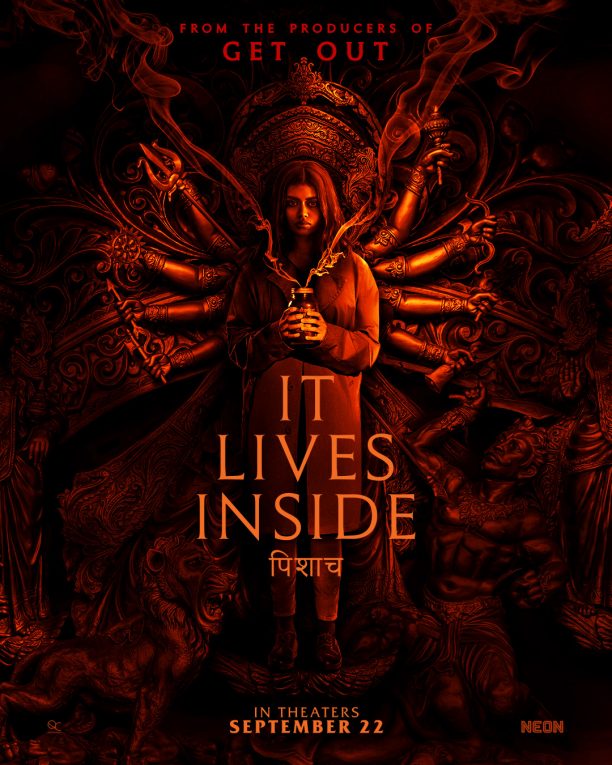 “It lives inside,” says a very frightened Tamira (Mohana Kirshnan) as she shows the jar she’s been carrying around to Sam (Megan Suri). “There’s something in here, I know you can’t see it, but it lives inside…all the stories we heard growing up, they’re all true, Sam.” With this, It Lives Inside tosses us into a world of tales handed down through generations, stories of rituals performed without always thinking of their deeper meaning, in a world that doesn’t always value those stories and rituals, all rolled into the package of an American supernatural horror film directed by Bishal Dutta.
“It lives inside,” says a very frightened Tamira (Mohana Kirshnan) as she shows the jar she’s been carrying around to Sam (Megan Suri). “There’s something in here, I know you can’t see it, but it lives inside…all the stories we heard growing up, they’re all true, Sam.” With this, It Lives Inside tosses us into a world of tales handed down through generations, stories of rituals performed without always thinking of their deeper meaning, in a world that doesn’t always value those stories and rituals, all rolled into the package of an American supernatural horror film directed by Bishal Dutta.
Tamira and Sam were best friends as children, but reaching adolescence and heading to high school sees them moving in different directions. Tamira still embraces her home culture. Sam is a South-Asian American teenager bristling against that home culture. She wants to be – and in fact is, for most of her day – just an ordinary American high school student, one minute depressed, one minute happy, riding on the roller coaster of emotions that comes with adolescence. For Sam’s mother, however, that home culture is important; it lives in the memories she has of cooking with her own mother, and in her first language, Hindi. It lives in the tiffin she prepares for her daughter, who leaves it behind as she tries to shed that culture when she walks out the door and heads to school.
It Lives Inside is a textbook example of the teen horror genre, in which a young protagonist (or protagonists) engages in a fight against some kind of menace – a serial killer, a monster, a ghost. In this case, the film gives us the Indian pishacha, a malevolent, flesh-eating demon, that may also feed on human energy. For Sam, it also means returning to her home culture, remembering the stories she was told, using what resources she has, even turning to Google, to find out the significance of clues she has to the pishacha and how to deal with it.
The horror genre is apt for a teenage adolescent tale, where the stresses of that phase of life can lead to depression or anxiety and can manifest in different ways, and where It Lives Inside works best is in showing us not only the stresses of an average American teenager, but also in adding in the challenges of coming from a culture that is “othered”, where the differences in dress, in food, in language already mark the teenager as “not one of us”. Tamira and Sam come from the same culture, live in the same community, go to the same school, but their outlooks are different. Tamira sits on the outside, still embracing her culture and the things that make her different from her schoolmates. Sam, on the other hand, rejects her home culture. She understands that doing this allows her to fit in better, to be just another kid in this school, wearing jeans, sneaking out to parties, hanging out with a boyfriend. It’s not completely effective, of course. There is the example of the (white) girl who is amused to learn Samita speaks “Hindu”, and Sam has to correct her, and be nice about those mistakes from someone who is amused by her home culture, and who isn’t really interested in her beyond that.
For all its reliance on Indian folklore, though, It Lives Inside is not a deep film. Its execution is pretty much in line with a standard teenage horror film, with the soundtrack and the jump scares doing a lot of the heavy lifting. I also enjoyed the film more when the supernatural being is not visible, where we see its traces, but where we don’t really see it at all, and when it finally takes on a physical form in the later portions of the film, I was somewhat disappointed. My preference is always to rely on stories, the ones Sam knows from her mother, who heard them from her own ayah. I acknowledge that other viewers will disagree with me, perhaps finding the full weight of evil can only be measured when the pishacha’s physical form is finally revealed. But the film’s worldbuilding and the mystery Sam must resolve were entirely enough to keep me engaged.
And, ultimately, a story about a teenager learning to come to terms with her past and her present, her home culture and the world outside, comes down to the very real rollercoaster of adolescent emotions. The wisdom to never go to sleep with a heavy heart, never allowing the dark to feed on the emotions so present in adolescence: anger, hatred, loneliness, all the things every teenager, no matter where they live, goes through. In the end, to defeat the pishacha, Sam must learn to reconcile the two parts of herself, to listen to the stories of her family, to understand the reasons behind the rituals and celebrations that she has come to reject, to be taught the things she needs to know by her mother. In the end, though, Sam must find the courage to face the pishacha.
Dutta’s film encourages us all to think about who we are, what our place in the world is, and to come to terms with what lives inside.









